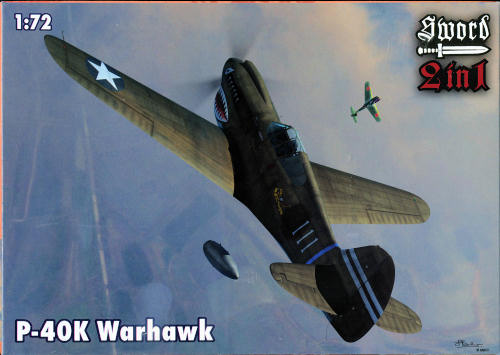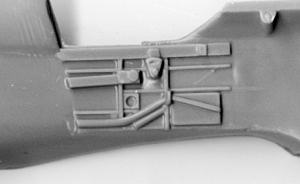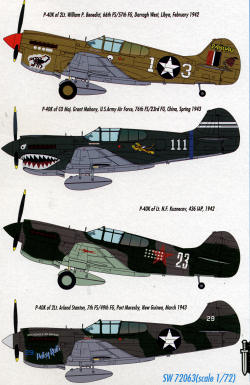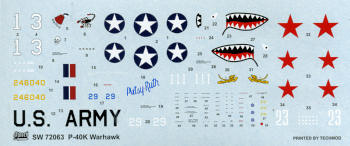
Sword 1/72 P-40K Warhawk
| KIT #: | SW 72063 |
| PRICE: | $44.95 SRP |
| DECALS: | Four options |
| REVIEWER: | Scott Van Aken |
| NOTES: | New tool? Two complete kits |

| HISTORY |
The Curtiss P-40 Warhawk was an American single-engine, single-seat, all-metal fighter and ground attack aircraft that first flew in 1938. The P-40 design was a modification of the previous Curtiss P-36 Hawk which reduced development time and enabled a rapid entry into production and operational service. The Warhawk was used by the air forces of 28 nations, including those of most Allied powers during World War II, and remained in front line service until the end of the war. It was the third most-produced American fighter, after the P-51 and P-47; by November 1944, when production of the P-40 ceased, 13,738 had been built, all at Curtiss-Wright Corporation's main production facilities at Buffalo, New York.
Warhawk was the name the United States Army Air Corps adopted for all models, making it the official name in the United States for all P-40s. The British Commonwealth and Soviet air forces used the name Tomahawk for models equivalent to the P-40B and P-40C, and the name Kittyhawk for models equivalent to the P-40D and all later variants.
P-40s first saw combat with the British Commonwealth squadrons of the Desert Air Force in the Middle East and North African campaigns, during June 1941. The Royal Air Force's No. 112 Squadron was among the first to operate Tomahawks, in North Africa, and the unit was the first Allied military aviation unit to feature the "shark mouth" logo, copying similar markings on some Luftwaffe Messerschmitt Bf 110 twin-engine fighters.
The P-40's lack of a two-stage supercharger made it inferior to Luftwaffe fighters such as the Messerschmitt Bf 109 or the Focke-Wulf Fw 190 in high-altitude combat and it was rarely used in operations in Northwest Europe. Between 1941 and 1944, however, the P-40 played a critical role with Allied air forces in three major theaters: North Africa, the Southwest Pacific and China. It also had a significant role in the Middle East, Southeast Asia, Eastern Europe, Alaska and Italy.
The P-40K variant was used wherever the earlier versions flew. It was considered to be the heaviest and slowest of all versions. This aircraft often had the extended fin fillet, though this feature was not unique to the K.
| THE KIT |
 This
is not the first P-40K to be molded in 1/72 as Vista, I believe, did one quite a
while back. I cannot say if this is the same kit so I am assuming it is a new
tool. It is a typical short run kit with a bit of flash and some mold 'stuff' on
the spinners that will be easily removed. I thought that the fuselage interior
detail was pretty well done so that should please several. The clear bit
This
is not the first P-40K to be molded in 1/72 as Vista, I believe, did one quite a
while back. I cannot say if this is the same kit so I am assuming it is a new
tool. It is a typical short run kit with a bit of flash and some mold 'stuff' on
the spinners that will be easily removed. I thought that the fuselage interior
detail was pretty well done so that should please several. The clear bit s
consist of a canopy/windscreen piece with the rear quarter windows being
separate. This will make it much easier to paint the scalloped area under them.
The cockpit is nicely done with raised instrument panel detail as well as a nice
seat rail on which the seat is placed then glued to the armor plating. There are
no seat belts but these can easily be added.
s
consist of a canopy/windscreen piece with the rear quarter windows being
separate. This will make it much easier to paint the scalloped area under them.
The cockpit is nicely done with raised instrument panel detail as well as a nice
seat rail on which the seat is placed then glued to the armor plating. There are
no seat belts but these can easily be added.
The exhaust can be installed from the outside, once
an 'L' shaped backing plate is glued on the inside of the nose section. In
addition to the usual coolant radiators, this kit also has the exit radiator
section, which will probably be visible if you install the optional open cowl
flap piece. Each of the main gear wells needs to be boxed in with four pieces.
There is also a separate gun insert for the lower part of the wing leading edge.
This should have the guns in the proper position instead of the center of the
leading edge as most other kits have portrayed in the past. The lone wheel
option is a covered wheel that is in two pieces. Also the only thing that can be
carried under the fuselage is a drop tank. This has four separate tank braces so
you might want to work out an easy way to do this. I would glue the braces to the fuselage first and use the drop tank to test
whether they are at the right inward angle.
would glue the braces to the fuselage first and use the drop tank to test
whether they are at the right inward angle.
The kit provided two complete kits so that will let you use up half of the four markings options.
The first is a sand over neutral grey aircraft of
William Benedict of the 66 FS/57 FG in Libya during early 1942. It has the red
spinner as a theather marking. The scorpion decal on the forward cowling does
not have the white b ackground
to it so you will need to paint that. A rather odd omission. Next is aircraft
111 of Grant Mahoney with the 76 FS/23 FG in China during the spring of 1943.
Standard OD/Neutral Grey scheme with a large shark mouth typical of the 23rd FG.
A Soviet aircraft of N.F.Kuznecov, 436 IAP in 1942 is next. This is in RAF
equivalent colors of dark earth/dark green over sky. Unusual for Soviet aircraft
are the upper wing insignia. Finally, from the 7FS/49FG in New Guinea during
1943 is the plane of Arland Stanton. This is in the same scheme as the previous
plane aside from neutral grey undersides. The tip of the spinner is in white.
The decals themselves are very nicely done so should go on with no issues. A
full stencil suite is provided and the instructions devote two pages to their
installation. I would have wished for more US insignia as there are only six of
them. This means you cannot do the first and last markings option together.
ackground
to it so you will need to paint that. A rather odd omission. Next is aircraft
111 of Grant Mahoney with the 76 FS/23 FG in China during the spring of 1943.
Standard OD/Neutral Grey scheme with a large shark mouth typical of the 23rd FG.
A Soviet aircraft of N.F.Kuznecov, 436 IAP in 1942 is next. This is in RAF
equivalent colors of dark earth/dark green over sky. Unusual for Soviet aircraft
are the upper wing insignia. Finally, from the 7FS/49FG in New Guinea during
1943 is the plane of Arland Stanton. This is in the same scheme as the previous
plane aside from neutral grey undersides. The tip of the spinner is in white.
The decals themselves are very nicely done so should go on with no issues. A
full stencil suite is provided and the instructions devote two pages to their
installation. I would have wished for more US insignia as there are only six of
them. This means you cannot do the first and last markings option together.
| CONCLUSIONS |
It is nice to have a kit available in this scale of this P-40 version as it is so frequently overlooked by kit makers. I will assume it is the need to have a separate molding for the new fin. However, we now have a very nice one and if you think the price is too high, you can easily go in with a friend to split the costs, thanks to having two kits. This one belongs in the collection of any 1/72 P-40 fan.
| REFERENCES |
http://en.wikipedia.org/wiki/P-40_Warhawk
August 2012
Thanks to Squadron Products for the preview kit. If your local shop does not have it, have them order it for you.
If you would like your product reviewed fairly and fairly quickly, please contact the editor or see other details in the Note to Contributors.